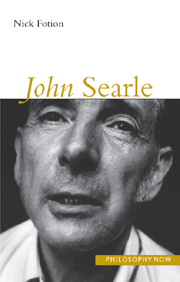Book contents
- Frontmatter
- Contents
- Introduction
- Part I Philosophy of language
- Part II Philosophy of mind
- 5 Intentionality of mind and language
- 6 Network and Background in mental states and language
- 7 Rediscovering the mind
- 8 Cognitive psychology and the unconscious
- Part III Philosophy of society and other matters
- Bibliography
- Index
5 - Intentionality of mind and language
from Part II - Philosophy of mind
- Frontmatter
- Contents
- Introduction
- Part I Philosophy of language
- Part II Philosophy of mind
- 5 Intentionality of mind and language
- 6 Network and Background in mental states and language
- 7 Rediscovering the mind
- 8 Cognitive psychology and the unconscious
- Part III Philosophy of society and other matters
- Bibliography
- Index
Summary
A shift of attention to intentionality of the mind
The appearance of Searle's next major work was anticipated by several articles (1979b; 1980a,b,c; 1982). He views these articles as preliminary sketches. The full title of the final and fully-formed canvas is Intentionality: An Essay in the Philosophy of Mind (1983). The title shows a shift of attention away from philosophy of language to a new subject. He still has many things to say about language, but now what he says has more to do with its status in relationship to other things rather than with the analysis of its details (e.g. its logical structure). In that connection, one of the major purposes of Intentionality is to show how language relates to the mind. Whatever Intentionality turns out to be, it will become clear shortly that one way mind and language relate to one another is that both exhibit Intentionality. But, it may be asked, do they do so in the same way? Is one form of Intentionality more basic than the other? Dealing with these and other questions thus shows that the shift to a new subject matter is not so great as at first it might be supposed since one purpose in coming to understand Intentionality is to come to a better understanding of language.
However, a second purpose is to show how the mind should be studied. Searle's view is that much of modern psychology is committed to theories of the mind that hold back progress in that field. In particular he is disturbed by certain theories of psychology that take the computer as the model for understanding the mind. With respect to the computer model, Intentionality is more a ground-laying work.
- Type
- Chapter
- Information
- John Searle , pp. 99 - 116Publisher: Acumen PublishingPrint publication year: 2000



